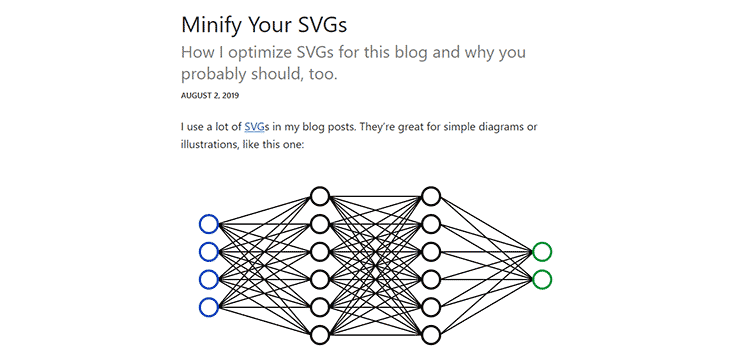
Svg minify code#
If you really need to bundle code that does this, you will likely need to use another bundler instead of esbuild. However, run-time file system emulation is out of scope and will not be implemented in esbuild. Some bundlers such as Webpack try to support this by including all potentially-reachable files in the bundle and then emulating a file system at run-time. You will then need to ensure that a copy of the external package is available to your bundled code at run-time. The way to work around this issue is to mark the package containing this problematic code as external so that it's not included in the bundle. Import * as esbuild from 'esbuild' let result = await esbuild.build(`) Here's a simple example that enables bundling with an output directory:ĬLI JS Go esbuild app.ts -bundle -outdir=dist You typically pass one or more entry point files to process along with various options, and then esbuild writes the results back out to the file system. This is the primary interface to esbuild. Each is described below at a high level, followed by documentation for each individual API option. The two most commonly-used esbuild APIs are build and transform. There is separate documentation for both of the public Go packages: pkg/api and pkg/cli. Go: If you are using Go, you may find the automatically generated Go documentation for esbuild helpful as a reference. You may also find the TypeScript type definitions for esbuild helpful as a reference. JavaScript: If you are using JavaScript be sure to check out the JS-specific details and browser sections below. The form -foo is used for enabling boolean flags such as -minify, the form -foo=bar is used for flags that have a single value and are only specified once such as -platform=, and the form -foo:bar is used for flags that have multiple values and can be re-specified multiple times such as -external. Some specifics for each language:ĬLI: If you are using the command-line API, it may be helpful to know that the flags come in one of three forms: -foo, -foo=bar, or -foo:bar. You can switch between languages using the CLI, JS, and Go tabs in the top-right corner of each code example. The concepts and parameters are largely identical between the three languages so they will be presented together here instead of having separate documentation for each language. Ok /tdewolff/minify/v2/js (cached)įAIL /tdewolff/minify/v2/minify The API can be accessed in one of three languages: on the command line, in JavaScript, and in Go. Minify/minify.go:23:115: cannot use js.Minify (value of type func(m *"/tdewolff/minify/v2".M, w io.Writer, r io.Reader, params mapstring) error) as type "/tdewolff/minify/v2".Minifier in argument to Default.AddRegexp:įunc(m *"/tdewolff/minify/v2".M, w io.Writer, r io.Reader, params mapstring) error does not implement "/tdewolff/minify/v2".Minifier (missing Minify method)įAIL /tdewolff/minify/v2/benchmarks Getting this error today: # /tdewolff/minify/v2/minify FAIL: TestJSVarRenaming/name=function()įAIL /tdewolff/minify/v2/js 0.039s Ok /tdewolff/minify/v2/cmd/minify (cached)


=> Validating source files with sha256sums.


 0 kommentar(er)
0 kommentar(er)
